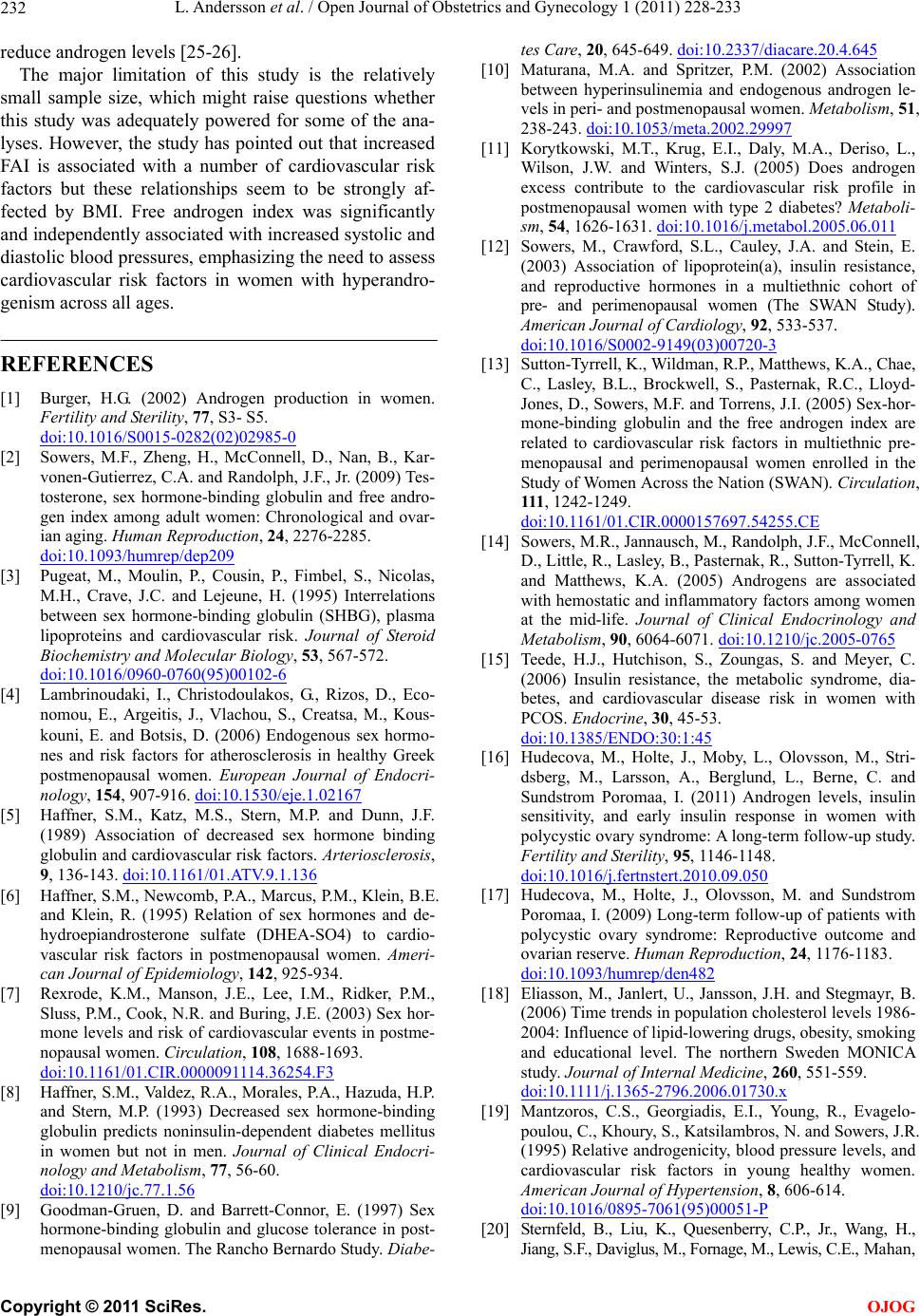
L. Andersson et al. / Open Journal of Obstetrics and Gynecology 1 (2011) 228-233
232
reduce androgen levels [25-26].
The major limitation of this study is the relatively
small sample size, which might raise questions whether
this study was adequately powered for some of the ana-
lyses. However, the study has pointed out that increased
FAI is associated with a number of cardiovascular risk
factors but these relationships seem to be strongly af-
fected by BMI. Free androgen index was significantly
and independently associated with increased systolic and
diastolic blood pressures, emphasizing the need to assess
cardiovascular risk factors in women with hyperandro-
genism across all ages.
REFERENCES
[1] Burger, H.G. (2002) Androgen production in women.
Fertility and Sterility, 77, S3- S5.
doi:10.1016/S0015-0282(02)02985-0
[2] Sowers, M.F., Zheng, H., McConnell, D., Nan, B., Kar-
vonen-Gutierrez, C.A. and Randolph, J.F., Jr. (2009) Tes-
tosterone, sex hormone-binding globulin and free andro-
gen index among adult women: Chronological and ovar-
ian aging. Human Reproduction, 24, 2276-2285.
doi:10.1093/humrep/dep209
[3] Pugeat, M., Moulin, P., Cousin, P., Fimbel, S., Nicolas,
M.H., Crave, J.C. and Lejeune, H. (1995) Interrelations
between sex hormone-binding globulin (SHBG), plasma
lipoproteins and cardiovascular risk. Journal of Steroid
Biochemistry and Molecular Biology, 53, 567-572.
doi:10.1016/0960-0760(95)00102-6
[4] Lambrinoudaki, I., Christodoulakos, G., Rizos, D., Eco-
nomou, E., Argeitis, J., Vlachou, S., Creatsa, M., Kous-
kouni, E. and Botsis, D. (2006) Endogenous sex hormo-
nes and risk factors for atherosclerosis in healthy Greek
postmenopausal women. European Journal of Endocri-
nology, 154, 907-916. doi:10.1530/eje.1.02167
[5] Haffner, S.M., Katz, M.S., Stern, M.P. and Dunn, J.F.
(1989) Association of decreased sex hormone binding
globulin and cardiovascular risk factors. Arteriosclerosis,
9, 136-143. doi:10.1161/01.ATV.9.1.136
[6] Haffner, S.M., Newcomb, P.A., Marcus, P.M., Klein, B.E.
and Klein, R. (1995) Relation of sex hormones and de-
hydroepiandrosterone sulfate (DHEA-SO4) to cardio-
vascular risk factors in postmenopausal women. Ameri-
can Journal of Epidemiology, 142, 925-934.
[7] Rexrode, K.M., Manson, J.E., Lee, I.M., Ridker, P.M.,
Sluss, P.M., Cook, N.R. and Buring, J.E. (2003) Sex hor-
mone levels and risk of cardiovascular events in postme-
nopausal women. Circulation, 108, 1688-1693.
doi:10.1161/01.CIR.0000091114.36254.F3
[8] Haffner, S.M., Valdez, R.A., Morales, P.A., Hazuda, H.P.
and Stern, M.P. (1993) Decreased sex hormone-binding
globulin predicts noninsulin-dependent diabetes mellitus
in women but not in men. Journal of Clinical Endocri-
nology and Metabolism, 77, 56-60.
doi:10.1210/jc.77.1.56
[9] Goodman-Gruen, D. and Barrett-Connor, E. (1997) Sex
hormone-binding globulin and glucose tolerance in post-
menopausal women. The Rancho Bernardo Study. Diabe-
tes Care, 20, 645-649. doi:10.2337/diacare.20.4.645
[10] Maturana, M.A. and Spritzer, P.M. (2002) Association
between hyperinsulinemia and endogenous androgen le-
vels in peri- and postmenopausal women. Metabolism, 51,
238-243. doi:10.1053/meta.2002.29997
[11] Korytkowski, M.T., Krug, E.I., Daly, M.A., Deriso, L.,
Wilson, J.W. and Winters, S.J. (2005) Does androgen
excess contribute to the cardiovascular risk profile in
postmenopausal women with type 2 diabetes? Metaboli-
sm, 54, 1626-1631. doi:10.1016/j.metabol.2005.06.011
[12] Sowers, M., Crawford, S.L., Cauley, J.A. and Stein, E.
(2003) Association of lipoprotein(a), insulin resistance,
and reproductive hormones in a multiethnic cohort of
pre- and perimenopausal women (The SWAN Study).
American Journal of Cardiology, 92, 533-537.
doi:10.1016/S0002-9149(03)00720-3
[13] Sutton-Tyrrell, K., Wildman, R.P., Matthews, K.A., Chae,
C., Lasley, B.L., Brockwell, S., Pasternak, R.C., Lloyd-
Jones, D., Sowers, M.F. and Torrens, J.I. (2005) Sex-hor-
mone-binding globulin and the free androgen index are
related to cardiovascular risk factors in multiethnic pre-
menopausal and perimenopausal women enrolled in the
Study of Women Across the Nation (SWAN). Circulation,
111, 1242-1249.
doi:10.1161/01.CIR.0000157697.54255.CE
[14] Sowers, M.R., Jannausch, M., Randolph, J.F., McConnell,
D., Little, R., Lasley, B., Pasternak, R., Sutton-Tyrrell, K.
and Matthews, K.A. (2005) Androgens are associated
with hemostatic and inflammatory factors among women
at the mid-life. Journal of Clinical Endocrinology and
Metabolism, 90, 6064-6071. doi:10.1210/jc.2005-0765
[15] Teede, H.J., Hutchison, S., Zoungas, S. and Meyer, C.
(2006) Insulin resistance, the metabolic syndrome, dia-
betes, and cardiovascular disease risk in women with
PCOS. Endocrine, 30, 45-53.
doi:10.1385/ENDO:30:1:45
[16] Hudecova, M., Holte, J., Moby, L., Olovsson, M., Stri-
dsberg, M., Larsson, A., Berglund, L., Berne, C. and
Sundstrom Poromaa, I. (2011) Androgen levels, insulin
sensitivity, and early insulin response in women with
polycystic ovary syndrome: A long-term follow-up study.
Fertility and Sterility, 95, 1146-1148.
doi:10.1016/j.fertnstert.2010.09.050
[17] Hudecova, M., Holte, J., Olovsson, M. and Sundstrom
Poromaa, I. (2009) Long-term follow-up of patients with
polycystic ovary syndrome: Reproductive outcome and
ovarian reserve. Human Reproduction, 24, 1176-1183.
doi:10.1093/humrep/den482
[18] Eliasson, M., Janlert, U., Jansson, J.H. and Stegmayr, B.
(2006) Time trends in population cholesterol levels 1986-
2004: Influence of lipid-lowering drugs, obesity, smoking
and educational level. The northern Sweden MONICA
study. Journal of Internal Medicine, 260, 551-559.
doi:10.1111/j.1365-2796.2006.01730.x
[19] Mantzoros, C.S., Georgiadis, E.I., Young, R., Evagelo-
poulou, C., Khoury, S., Katsilambros, N. and Sowers, J.R.
(1995) Relative androgenicity, blood pressure levels, and
cardiovascular risk factors in young healthy women.
American Journal of Hypertension, 8, 606-614.
doi:10.1016/0895-7061(95)00051-P
[20] Sternfeld, B., Liu, K., Quesenberry, C.P., Jr., Wang, H.,
Jiang, S.F., Daviglus, M., Fornage, M., Lewis, C.E., Mahan,
C
opyright © 2011 SciRes. OJOG